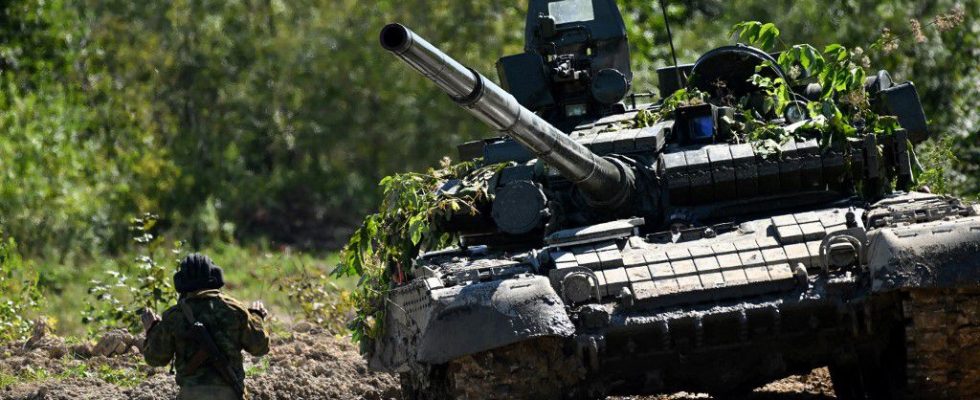After months of preparation, kyiv’s forces are back on the attack. On Monday, the Ukrainian authorities announced the reconquest of “seven villages” since this weekend, in the south and east of the country. At the same time, the first Ukrainian losses – and in particular of Western armored vehicles – have been recorded. “The fighting is difficult, but we are making progress,” summed up President Volodymyr Zelensky. “The Ukrainians have penetrated the enemy system and they are advancing at a faster pace than the Russians in recent months”, but the fortifications erected by Putin’s forces remain “solid and rely on many lines of defense”, underlines General Nicolas Richoux, former commander of the 7th Armored Brigade. Overview of current operations.
L’Express: Ukraine said on Monday that it had taken back 90 km2 from Russian forces. Is the great Ukrainian counter-offensive really underway?
Nicholas Richoux: For the moment, I see it more as a series of localized counter-attacks aimed at regaining ground than the major Ukrainian offensive itself. Let us remember that the forces of kyiv formed nearly 14 brigades, which represents several tens of thousands of men. However, for the moment, the Ukrainians do not seem to have committed most of these troops. It could therefore still be a phase of preparation for the offensive, intended to regain the initiative on the ground, while preserving the bulk of the troops. Politically, this in any case allows the Ukrainians to regain the upper hand after the capture of Bakhmout by the Russians last month.
Could it also be a “deception” action aimed at maintaining the blur on the main axis of attack?
Absolutely, this typically military term refers to deceiving the enemy. A deception operation aims to make people believe in an attack on a given point, before carrying out the bulk of military operations on another. This could be the case here. We note, moreover, that the Ukrainians have several axes of attack, spread over a line of about 500 kilometers. The objective could therefore also be to carry out offensive reconnaissance: that is to say, to seek intelligence, by engaging in combat. This makes it possible to test the Russian defenses, and to detect possible weak points.
“The Ukrainians will have to ensure that these victories do not come at too high a cost”
How are these counter-attacks going so far?
There have been territorial gains, so we can salute these successes. The Ukrainians have penetrated the opposition and they are advancing at a faster pace than the Russians in recent months. We see that they lead their attacks in a fairly traditional way: first of all a shelling by artillery, supported by drones, then an assault launched by tanks – some of which are Western -, followed by infantry.
Besides, there has been no breakthrough in the depth of the enemy lines yet. If we take an overall view of the Ukrainian front, we see that it has not changed radically. And knowing that there are only about three months left before the rains arrive, it seems that it will be difficult to push the Russians out of the country in this time frame. The Ukrainians will therefore have to ensure that these victories do not come at too high a cost. Because if they suffer excessive losses, this risks jeopardizing the rest of their operations.
Especially since the Russians had time to prepare their lines of defense…
Absolutely. They still hold deep positions, and have had months to settle there. Their defensive system is solid and relies on many lines of defense, which are interconnected, and each consists of several lines of trenches. This is the reason why they are difficult to drill. The Russian army is certainly an army in poor health, badly equipped and badly commanded, but it is not yet a defeated army in the military sense of the term.
Russian propaganda has widely relayed in recent days the images of a damaged German Leopard 2 tank, surrounded by several other destroyed Western armored vehicles. Is it really worrying?
There is nothing surprising in seeing Western armor destroyed, insofar as there is always breakage during an offensive operation. It would be absurd to believe that the Leopard 2 is an invulnerable tank. You can’t go on the attack without suffering losses, and the attacker always has more than the defender, for the simple reason that he exposes himself more. Even if they are powerful, it is therefore necessary to expect to see other Western tanks destroyed, as soon as they are used on the battlefield.
Moreover, we see that the Leopard 2 appearing on this photo did not burn, unlike the Russian T-72s which have a tendency to explode and send their turret flying in the air. Potentially, this Ukrainian tank could therefore be repaired in order to be reused on the front. In fact, what bothers me the most in this photo is the proximity of all the Ukrainian armored vehicles: during an armored maneuver, it is better to keep a certain distance between them, to be less vulnerable to enemy attacks.
Should we expect Russia to try to exploit every image of destroyed Western armor in this way, to try to impose the narrative of a failure of the Ukrainian counter-offensive?
Yes. From the moment the Russians are on the defensive, they will try to exploit every image that could seem favorable to them. Their goal is to make Ukrainians and Westerners doubt themselves. But seeing Western armor destroyed does not necessarily mean that the Ukrainian counter-offensive is a failure. It is simply a sad reality in times of war. Let us remember that during World War II, thousands of American and Russian tanks were destroyed by German forces. Finally, we can point out that the Russians rotated the same photo in a loop, from different angles, for several days. This pretty much proves the fact that they didn’t have much else to show.
